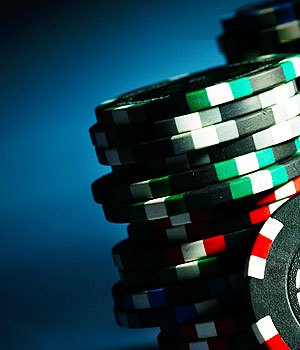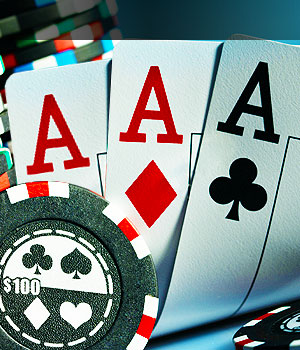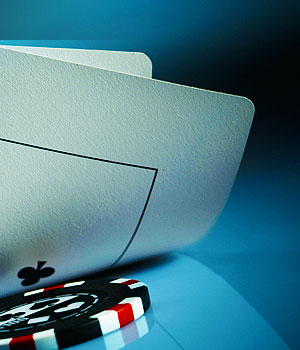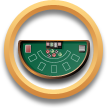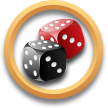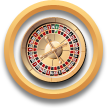Poker Hands
The hands are ranked in the order they are because of the relative probabilities of them being dealt, with rarer hands ranking above more common hands.
All five-card poker hands can be collapsed down to 7,462 distinct equivalence classes. For example, there are 24 different ways to create an aces over kings full house hand, but since they all hold the same poker ranking value, they can be collapsed into the same equivalence class. In this way, all 2,598,960 unique five card poker hands can be shrunk down to just 7,462 distinct classes of hands.
Straight Flush
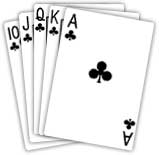
A straight flush is a poker hand such as 8♠ 9♠ 10♠ J♠ Q♠, which contains five cards in sequence, all of the same suit. Two such hands are compared by their high card in the same way as are straights. The low ace rule also applies: A♣ 2♣ 3♣ 4♣ 5♣ is a 5-high straight flush (also known as a "steel wheel"). An ace-high straight flush such as 10♣ J♣ Q♣ K♣ A♣ is known as a royal flush, and is the highest ranking standard poker hand.
Four of a kind
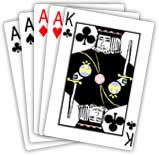
Four of a kind, also known as quads, is a poker hand such as A♣ A♠ A◆ A♥ K♥, which contains four cards of one rank, and an unmatched card. It ranks above a full house and below a straight flush. Higher ranking quads defeat lower ranking ones. Ties may be broken by the single kicker (in games with community or wild cards).
Full House
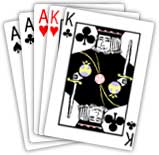
A full house, also known as a full boat, is a poker hand such as A♣ A♠ A◆ K♥ K♣, which contains three matching cards of one rank, plus two matching cards of another rank (known as the kicker). It ranks below a four of a kind and above a flush. Between two full houses, the one with the higher ranking set of three wins. The hand with the higher pair (kicker) wins if two hands have the same set of three cards (possible in wild card and community card games). Full houses are described by the three of a kind (e.g. Q-Q-Q) and pair (e.g. 9-9), as in "Queens over nines" (also used to describe a two pair), "Queens full of nines" or simply "Queens full".
Flush
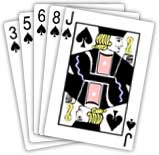
>A flush is a poker hand such as 3♠ 5♠ 6♠ 8♠ J♠, which contains five cards of the same suit, not in rank sequence. It ranks above a straight and below a full house. Two flushes are compared as if they were high card hands. In other words, the highest ranking card of each is compared to determine the winner; if both have the same high card, then the second-highest ranking card is compared, etc. The suits have no value: two flushes with the same five ranks of cards are tied. Flushes are described by the highest card, as in "queen-high flush".
Straight
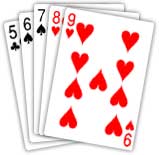
A straight is a poker hand such as 5♣ 6♠ 7♠ 8♥ 9♥, which contains five cards of sequential rank but more than one suit. It ranks above three of a kind and below a flush. Two straights are ranked by comparing the high card of each. Two straights with the same high card are of equal value, and split any winnings (straights are the most commonly tied hands in poker, especially in community card games). Straights are described by the highest card, as in "queen-high straight" or "straight to the queen".
A hand such as 10♣ J♣ Q◆ K♠ A♠ is an ace-high straight, and ranks above a king-high straight such as 9♥ 10♠ J♥ Q♥ K◆. But the ace may also be played as a 1-spot in a hand such as A♠ 2◆ 3◆ 4♠ 5♣, called a wheel or five-high straight, which ranks below the six-high straight 2♠ 3♣ 4♣ 5♥ 6♥. The ace may not "wrap around", or play both high and low in the same hand: Q♣ K◆ A♠ 2♠ 3♣ is not a straight, but just ace-high no pair.
Two Pair
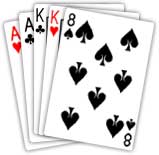
A poker hand such as A♥ A♣ K♣ K♥ Q♠, which contains two cards of the same rank, plus two cards of another rank (that match each other but not the first pair), plus one unmatched card, is called two pair. It ranks above one pair and below three of a kind. Between two hands containing two pair, the higher ranking pair of each is first compared, and the higher pair wins. If both have the same top pair, then the second pair of each is compared. Finally, if both hands have the same two pairs, the kicker determines the winner. Two pair are described by the higher pair (e.g., K♥ K♣) and the lower pair (e.g., 9♠ 9◆), as in "Kings over nines", "Kings and nines" or simply "Kings up".
One Pair
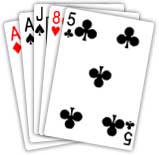
One pair is a poker hand such as A♥ A♠ K♠ J♥ 6♣, which contains two cards of the same rank, plus three unmatched cards. It ranks above any high card hand, but below all other poker hands. Higher ranking pairs defeat lower ranking pairs. If two hands have the same rank of pair, the non-paired cards (the kickers) are compared to determine the winner.
High Card
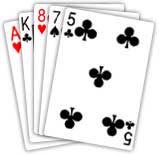
A high-card or no-pair hand is a poker hand such as A♥ K♣ 8♥ 7♠ 5♣, in which no two cards have the same rank, the five cards are not in sequence, and the five cards are not all the same suit. It can also be referred to as "nothing" or "garbage," and many other derogatory terms. It ranks below all other poker hands. Two such hands are ranked by comparing the highest ranking card; if those are equal, then the next highest ranking card; if those are equal, then the third highest ranking card, etc. No-pair hands are described by the one or two highest cards in the hand, such as "king high" or "ace-queen high", or by as many cards as are necessary to break a tie.
The lowest possible high card is seven-high (7-5-4-3-2), because 6-5-4-3-2 would be a straight.

